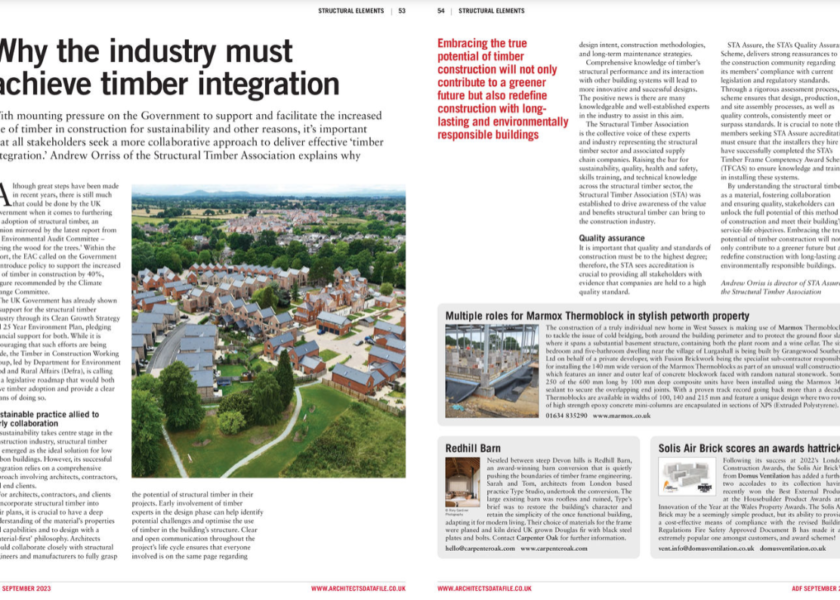Why the Industry must achieve timber integration
06/09/2023

With mounting pressure on the Government to facilitate the increased use of timber in construction, it is increasingly important for all stakeholders to seek a more collaborative approach to deliver effective timber integration and meet buildings’ service-life objectives – as Andrew Orriss of the Structural Timber Association explains.
Although great steps have been made in recent years, there is still much that could be done by the UK Government when it comes to furthering the adoption of structural timber, an opinion mirrored by the latest report from the Environmental Audit Committee – ‘Seeing the wood for the trees’. Within the report, the EAC called on the Government to introduce policy to support the increased use of timber in construction by 40%, a figure recommended by the Climate Change Committee.
The UK Government has already shown its support for the structural timber industry through their Clean Growth Strategy and 25 Year Environment Plan, pledging financial support for both. While it is encouraging that such efforts are being made, the Timber in Construction Working Group, led by Department for Environment Food and Rural Affairs (DEFRA), is calling for a legislative roadmap that would both drive timber adoption and provide a clear means of doing so.
Sustainable Practice and Early Collaboration
As sustainability takes centre stage in the construction industry, structural timber has emerged as the ideal solution for low carbon buildings. However, its successful integration relies on a comprehensive approach involving architects, contractors, and end clients.
For architects, contractors, and clients to incorporate structural timber into their plans, it is crucial to have a deep understanding of the material’s properties and capabilities and to design with a material first philosophy. Architects should collaborate closely with structural engineers and manufacturers to fully grasp the potential of structural timber in their projects. Early involvement of timber experts in the design phase can help identify potential challenges and optimise the use of timber in the building’s structure. Clear and open communication throughout the project’s lifecycle ensures that everyone involved is on the same page regarding design intent, construction methodologies, and long-term maintenance strategies.
Comprehensive knowledge of timber’s structural performance and its interaction with other building systems will lead to more innovative and successful designs. The positive news is there are many knowledgeable and well-established experts in the industry.
The Structural Timber Association is the collective voice of these experts and industry representing the structural timber sector and associated supply chain companies. Raising the bar for sustainability, quality, health and safety, skills training, and technical knowledge across the structural timber sector, the STA was established to drive awareness of the value and benefits structural timber can bring to the construction industry
Quality Assurance and STA Assure
It is important that quality and standards of construction must be to the highest degree; therefore, the STA see that accreditation is crucial to providing all stakeholders with evidence that companies are held to a high quality standard.
STA Assure, the STA’s Quality Assurance Scheme, delivers strong reassurances to the construction community regarding its members’ compliance with current legislation and regulatory standards. Through a rigorous assessment process, the scheme ensures that design, production, and site assembly processes, as well as quality controls, consistently meet or surpass standards. It is crucial to note that members seeking STA Assure accreditation must ensure that the installers they hire have successfully completed the STA’s Timber Frame Competency Award Scheme (TFCAS) to ensure knowledge and training in installing these systems
By understanding the structural timber as a material, fostering collaboration and ensuring quality, stakeholders can unlock the full potential of this method of construction and meet their building’s service-life objectives. Embracing the true potential of timber construction will not only contribute to a greener future but also redefine construction with long-lasting and environmentally responsible buildings.
Go to article https://content.yudu.com/web/1yxz1/0A44942/Sept23/html/index.html?